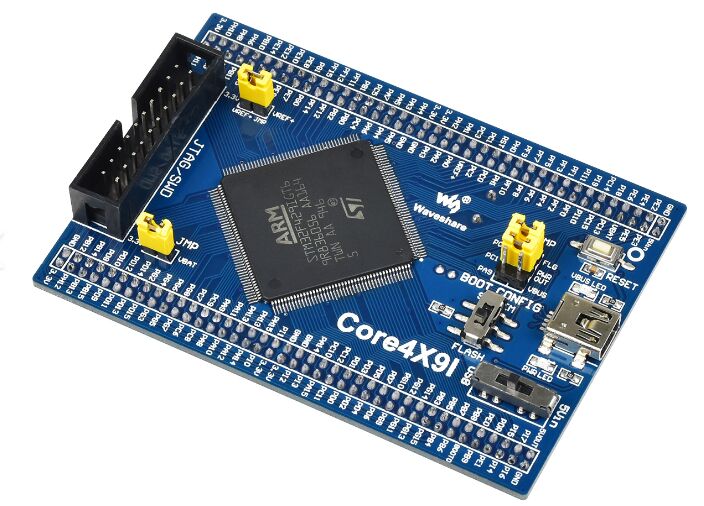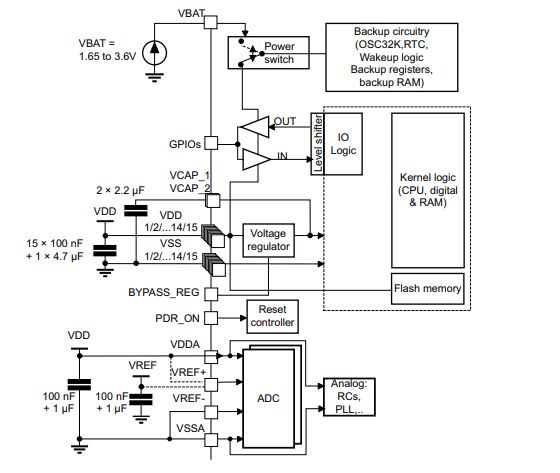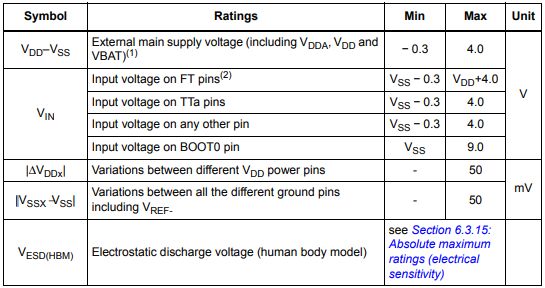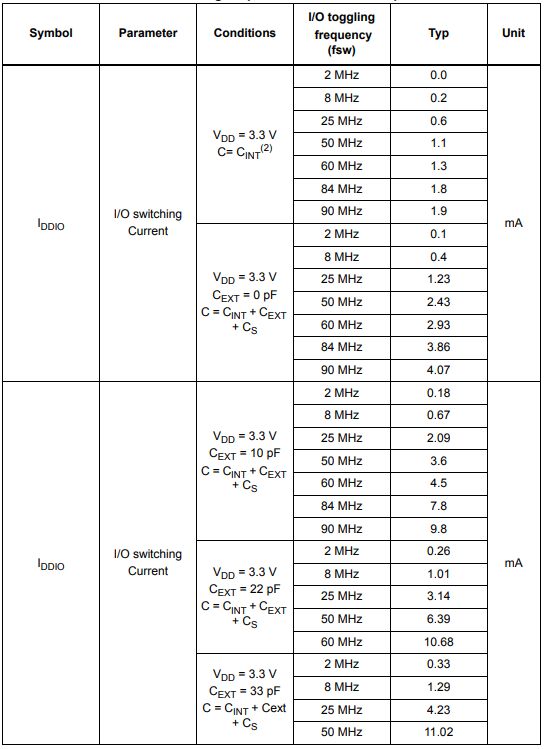By STMicroelectronics 139
STM32F429IGT6 is a 32-bit ARM Cortex-M4 core microcontroller. The Cortex-M4 core is a low-power, high-performance processor core suitable for embedded systems.
The chip contains a wealth of hardware features, such as Flash and SRAM, for storing programs and data. It also includes multiple communication interfaces (such as SPI, I2C, UART, etc.), timers, ADC and other peripherals to meet various application needs.

Ⅰ.Specifications of STM32F429IGT6
•Number of digits:32
•Number of pins:176
•Length:24.1 mm
•Width:24.1 mm
•Height:1.45 mm
•Humidity Sensitivity:Yes
•Products:MCU+FPUs
•Clock frequency:180 MHz
•Program memory type:Flash
•DAC resolution:12 bit
•Data Ram type:SRAM
•Product category:ARM microcontroller-MCU
•Installation style:SMD/SMT
•Package/Case:LQFP-176
•Program memory size:1 MB
•Data bus width:32 bit
•ADC resolution:12 bit
•Maximum clock frequency:180 MHz
•Number of input/output terminals:140 I/O
•Data RAM size:260 kB
•Supply voltage-Minimum:1.7 V
•Supply voltage-Max:3.6 V
•Minimum operating temperature:-40℃
•Maximum operating temperature:+85℃
•Number of ADC channels:24 Channel
•Analog power supply voltage:1.7V to 3.6V
•Number of timers/counters:14 Timer
•Data converter:A/D 24x12b; D/A 2x12b
•Interface type:CAN,I2C,SAI,SPI,UART/USART,USB
Ⅱ.Functional features of STM32F429IGT6
1.Clock and power management: Supports multiple clock sources and power modes, which can be flexibly adjusted to meet the power consumption and performance requirements of different applications.
2.With SDRAM interface, Chrom-ART and LCD-TFT controller.
3.Integrated large-capacity Flash and SRAM for storing program code and data.
4.Power saving mode is designed for low power consumption applications.
5.Communication interface: USART, UART, SPI, I2C, CAN and SDIO.
6.Temperature sensor: Integrated temperature sensor can be used to monitor the working temperature of the chip.
7.USB interface: Supports USB interface, which can be used to connect external devices, such as USB memory, USB keyboard, etc.
8.With 180MHz CPU, running up to 256KB SRAM and up to 2MB dual memory bank flash
9.Graphics processing: Some STM32F429 series chips include the Chrom-ART accelerator, which is specially used to accelerate graphics processing and rendering.
10.Touch screen controller: A touch screen controller is also included, suitable for applications that support touch screens.
11.With Ethernet MAC and camera interface for CMOS sensor
12.Flexible memory controller and supports Compact Flash, SRAM, PSRAM, NOR and NAND and SDRAM memory.
13.LCD controller: Integrated LCD controller, supports connection to LCD display, suitable for embedded graphical interface applications.
14.DMA controller: Integrated DMA controller to improve data transmission efficiency.
Ⅲ.Power supply scheme of STM32F429IGT6

Ⅳ.Application fields of STM32F429IGT6
•Communication field: inverters, PLCs, scanners, video intercoms, etc.
•Industrial automation: used for motor control, sensor data collection and processing, etc.
•Medical equipment: such as smart blood pressure monitors, smart blood glucose meters, smart medical beds, etc.
•Smart home: such as smart lighting, smart security, smart home appliance control, etc.
•Embedded graphical interface applications: Through the built-in LCD controller and Chrom-ART accelerator, it is suitable for embedded graphical interface applications, such as dashboards, touch screen control panels, etc.
•Automotive electronics: Suitable for automotive electronic systems, including vehicle control units (ECUs), instrument panels, entertainment systems, etc.
•Aerospace: Used in flight control systems, navigation systems and other critical applications.
•Industrial control systems: used to control and monitor industrial control systems, including PLCs and data acquisition equipment.
Ⅴ.Voltage characteristics of STM32F429IGT6

Ⅵ.In STM32F429IGT6, the difference between Stack and Heap
1.Stack
• Fast: The stack is allocated and deallocated very quickly because the pointer is simply moved.
•Purpose: The stack is mainly used to store local variables, function parameters, return addresses, etc. when calling functions.
•Allocation and release: Stack allocation and release are automatically performed by the system, usually when function calls and returns occur.
•Fixed size: The size of the stack is fixed when the program is running and is determined by the compiler or system configuration. Stack space is usually relatively small.
2.Heap
•Slower:Heap allocation and freeing may be relatively slow due to the need to search for available memory blocks and there may be memory fragmentation issues.
•Purpose:The heap is used to dynamically allocate memory, that is, allocate and release memory space as needed at runtime.
•Dynamic size:The size of the heap can be adjusted dynamically while the program is running, depending on allocation and deallocation operations.
•Allocation and deallocation:Heap allocation and deallocation is done manually by the programmer, usually using functions such as malloc() and free(). This allows for more flexible memory management.
Ⅶ.Switching output I/O current consumption of STM32F429IGT6

Ⅷ.Power management and low power consumption features of STM32F429IGT6
1.Power mode: STM32F429IGT6 supports multiple power modes, including running mode, low power mode and standby mode. In different modes, the power consumption levels of the chip are different and can be selected according to application requirements.
•Running mode: This is the normal working mode of STM32F429IGT6. At this time, the CPU and all peripherals are working normally and can execute all instructions and operations. Run mode consumes relatively high power but provides the highest performance and functionality.
•Low power mode: STM32F429IGT6 supports multiple low power modes, which are designed to reduce power consumption while maintaining certain functionality. For example, in low-power mode, the CPU can enter a sleep state and stop executing instructions, but can still monitor interrupt events or external events. This can greatly reduce power consumption.
•Standby mode: Standby mode is the lowest power consumption mode. At this time, most systems are in sleep state and only some systems are running. For example, the RTC and backup registers may continue to function. When the system needs to be woken up, it can be done through an external interrupt or hardware reset.
2.Internal temperature sensor: STM32F429IGT6 usually integrates an internal temperature sensor, which can be used to monitor the chip operating temperature. This is helpful for optimizing power consumption and system stability.
3.Clock management: STM32F429IGT6 provides a flexible clock management mechanism that can dynamically adjust the clock frequency to reduce power consumption. This flexibility is useful for minimizing power consumption in different operating modes.
4.Power domain: STM32F429IGT6 is usually divided into different power domains, and the power consumption of certain power domains can be selectively turned off or reduced to further optimize system power consumption. Common power domains:
•Main power domain: This is the power domain that supplies core logic such as CPU, memory and cache. Normally, the main power domain remains on to ensure the normal operation of the system's core functions.
•Independent functional unit power domains: These are power domains designed for certain specific functions, such as ADC, DAC, PLL, etc. These power domains can be turned on or off independently to optimize power consumption without affecting other parts.
•Peripheral power domain: The peripheral power domain supplies power to various peripheral modules (such as GPIO, UART, SPI, I2C, etc.). Developers can selectively turn on or off these power domains according to actual needs. For example, in low-power mode, it may be necessary to maintain only necessary peripheral functions and turn off other unnecessary peripheral power domains.
•Analog and digital power domains: Depending on the needs of the system, analog circuits and digital circuits are sometimes divided into different power domains. This provides better isolation of noise interference between different circuits and allows independent optimization of power consumption.
Frequently Asked Questions
1.What are the main hardware features of STM32F429IGT6?
STM32F429IGT6 includes features such as high-speed embedded flash memory, static RAM, various communication interfaces (SPI, I2C, UART), timers, ADC, LCD controller, and more.
2.How does STM32F429IGT6 support power management and low-power modes?
STM32F429IGT6 supports different power modes, including run mode, low-power modes, and standby mode. Developers can leverage these modes to optimize power consumption based on the application's requirements.
3.Does STM32F429IGT6 have special power management features?
STM32F429IGT6 has special power management features. It integrates multiple power management modules, which can flexibly control different peripherals and achieve refined power consumption management.